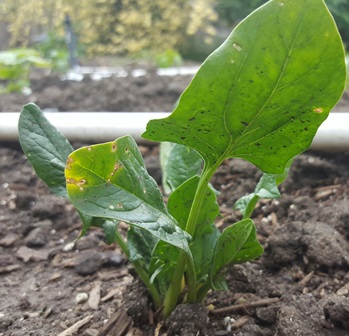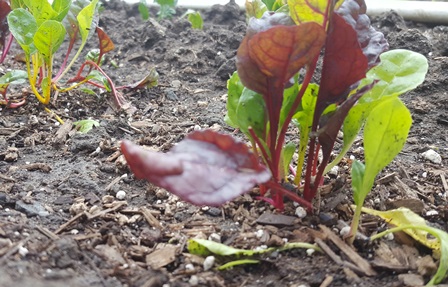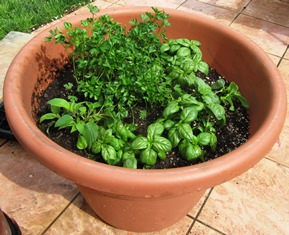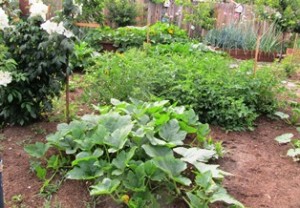Grow Seasonal Greens Now
The cool season of spring is the optimum time to grow seasonal greens for salads and healthy blended shakes. In my kitchen garden, I’ve planted a variety of lettuces, spinach, kale, and chard. Most salad greens are easy to grow also in containers, raised beds, and window boxes when gardening space is limited.
Add compost and aged chicken manure to enrich the soil with nitrogen. Plant heirloom seeds about 1/2 inch in the soil, cover, and water. Within a week or 10 days, you should see the seedlings pop up. The greens will be ready to pick in about 25 days.
Water the plants to keep them hydrated but don’t drown the plants. When you are ready to make a salad, snip the leaves you want with kitchen scissors. New leaves will soon form if the roots are not disturbed and the plant continues to get nutrients and water.

Spinach can be started in seed cell flats and then transplanted into your garden when all danger of frost has passed
SALAD OF FRESH GREENS
1. Snip a variety of greens in the early morning. Wash and thoroughly dry the leaves.
2. Place them in a bowl and crumble on some sharp cheese such as your favorite goat cheese or a Gargonzola (blue-veined, sharp tasting, and crumbly).
3. Add 1/2 cup sugared or candied walnuts.
4. Add some slice red onion and a handful of dried cranberries or chopped dried apricots.
5. Drop into the bowl some slices of a pear such as Bosc (considered the prince of pears).
6. Gently toss the salad and then spritz with red wine vinaigrette prior to plating on pretty salad serving dishes.
* * *
If you love reading about gardening and other farming topics, check out my Henny Penny Farmette series of cozy mysteries that include A BEELINE TO MURDER, THE MURDER OF A QUEEN BEE, and A HIVE OF HOMICIDES.
-
Delicious recipes
-
Farm quips and quotes
-
Tips for gardening and keeping chickens and bees
-
An exciting whodunnit mystery
Twelve Reasons to Grow Your Own Food
Doctors tell us we should eat fruits and vegetables for our health. Fresh is best. For more reasons to grow your own food, read on.
1. Enjoy Superior Flavor and Higher Nutritional Value
The flavor of produce that travels from your edible garden to your plate is far superior to that of store-bought varieties. Even before fresh produce reaches the bins of your local store, the fruits and vegetables must be picked, sorted, crated, and transported from suppliers t0 supermarkets and grocery stores. Time spent in transporting and storage can diminish food flavors and nutrient values.
2. Keep It Pesticide-Free
Go organic. Choose alternative methods (companion planting and organic sprays, for example) to treat garden pests and plant diseases. Organic farming starts with nourishing the soil, which in turn, nourishes the plants that nourishes a healthy body. Organically grown fruits and vegetables picked fresh, immediately prepared, and served are nutritionally superior than their commercially grown and stored counterparts.
3. Safeguard Your Health
Avoid the cancer-causing agents and toxic chemicals in pesticides that are commonly used on many commercially grown food products.
4. Cultivate Plant Diversity; Preserve History
Grow varieties of the vegetables and fruits you love. Or, choose cultivars that might have grown in your grandmother’s garden–a nod to preserving history. Or, plant varieties that have fallen out of favor, are unusual, or are even rare.
5. Lower Your Food Bill
Grow your own edibles and preserve them for later consumption (like freezing spring peas for a fall or winter meal). Preserving the bounty by drying or freezing or canning can reduce your grocery bills. Another cost and time saver is to grow hard-to-find varieties of heirloom herbs, vegetables, or fruits instead of tracking down sources for those items.
6. Expand Your Knowledge of Plants
Understanding the seed-to-harvest cycle in nature fosters deep appreciation for ecology and the environment and contributes to your knowledge about various plants’ needs for nutrients, water, light, and temperature. You also learn about treatment options for garden-variety pests and plant diseases. This wealth of information can be shared with younger generations who will inherit the responsibility of caring for the planet.
7. Get Exercise
You can still work out, albeit in the garden in the fresh air rather than in an indoors gym. Think about all the exercise you’ll get digging, planting, shoveling, watering, weeding, and composting. Gardening provides plenty of solid exercise and rejuvenates a weary spirit.
8. Reduce Your Stress
Time spent in a garden is restorative: it nourishes your spirit and reduces stress levels. In fact, just a few moments of deep breathing and thinking about birdsong, sunshine, fresh air, and healthy plants all around you–nature in all its splendor–can generate a positive mental attitude.
9. Alleviate Concerns about Food Safety and Quality
You know the quality of the food you bring from your edible garden to the table. You want the superior freshness, flavor, and food quality for your loved ones. The chances for food-borne illnesses of the kind that strike Americans every year and are often investigated by the Centers for Disease Control (CDC) are vastly diminished when you grow organic edibles and eat them as fresh as possible.
10. Preserve Our Planet’s Diversity
Choose seeds that are open-pollinated, non-GMO (genetically modified organism; the result of scientists engineering or modifying the genetic material of food plants). It may come as no surprise that the health of our nation has declined with the demise of small family farms even as there’s been a rise in the number of supermarkets and expansion of modern agribusiness. It’s no wonder people everywhere are getting behind buy-local, keep-it-local movements; participating in farmers’ markets, and engaging in urban homesteading where self-reliance is paramount.
11. Earn Extra Money
Selling your home-grown produce to others in your community means you can make possible the goodness of organic produce to others while earning a little money (hint: buy more seeds or otherwise reinvest in your garden).
12. Feel Good about Donating Excess Produce to a Food Bank
Your local food bank or (sometimes churches, too) will distribute donated produce to needy families. Let it be a source of joy for you that your gardening efforts have literally put food in the mouths of those in less fortune life circumstances.
 Facebook
Facebook Goodreads
Goodreads LinkedIn
LinkedIn Meera Lester
Meera Lester Twitter
Twitter






